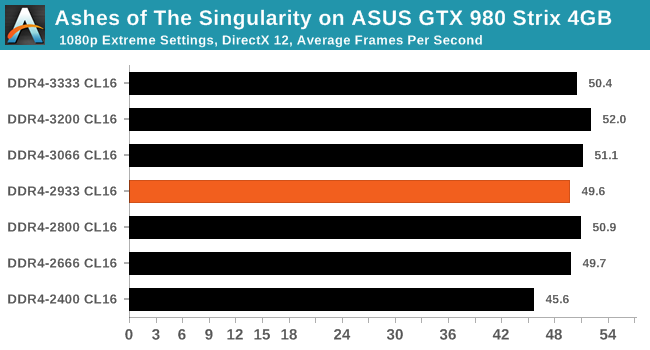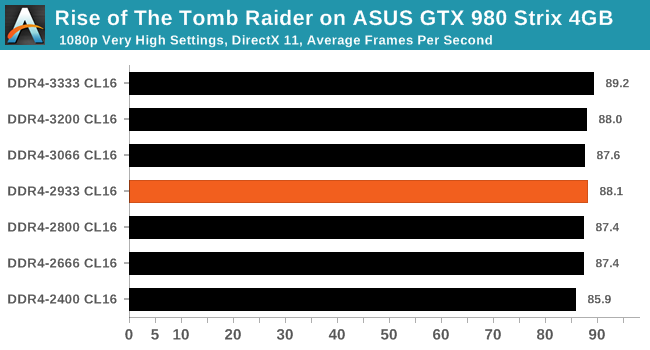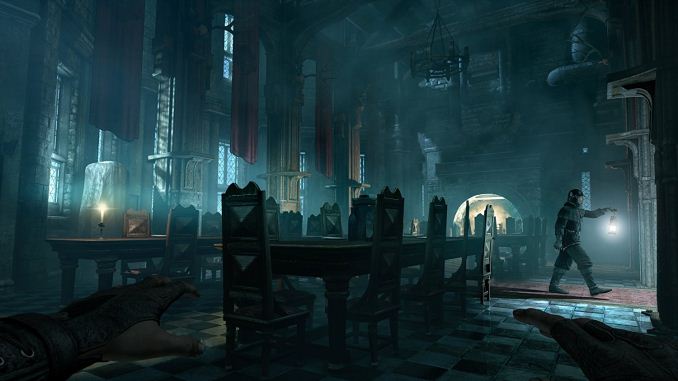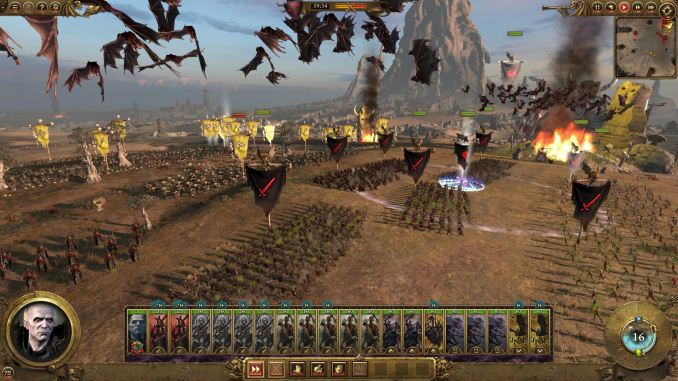Memory Scaling on Ryzen 7 with Team Group's Night Hawk RGB
by Ian Cutress & Gavin Bonshor on September 27, 2017 11:05 AM ESTGaming Performance
Ashes of the Singularity (DX12)
Seen as the holy child of DX12, Ashes of the Singularity (AoTS, or just Ashes) has been the first title to actively go and explore as many of the DX12 features as it possibly can. Stardock, the developer behind the Nitrous engine which powers the game, has ensured that the real-time strategy title takes advantage of multiple cores and multiple graphics cards, in as many configurations as possible.

Performance with Ashes over our different memory settings was varied at best. The DDR4-2400 value can certainly be characterized as the lowest number near to ~45-46 FPS, while everything else is rounded to 50 FPS or above. Depending on the configuration, this could be an 8-10% difference in frame rates by not selecting the worst memory.
Rise Of The Tomb Raider (DX12)
One of the newest games in the gaming benchmark suite is Rise of the Tomb Raider (RoTR), developed by Crystal Dynamics, and the sequel to the popular Tomb Raider which was loved for its automated benchmark mode. But don’t let that fool you: the benchmark mode in RoTR is very much different this time around.
Visually, the previous Tomb Raider pushed realism to the limits with features such as TressFX, and the new RoTR goes one stage further when it comes to graphics fidelity. This leads to an interesting set of requirements in hardware: some sections of the game are typically GPU limited, whereas others with a lot of long-range physics can be CPU limited, depending on how the driver can translate the DirectX 12 workload.

We encountered insignificant performance differences in RoTR on the GTX 980. The 3.3 FPS increase at average framerates from top to bottom does not exactly justify the price cost between DDR4-2400 and DDR4-3333 when using a GTX 980 - not in this particular game at least.
Thief
Thief has been a long-standing title in the hearts of PC gamers since the introduction of the very first iteration back in 1998 (Thief: The Dark Project). Thief is the latest reboot in the long-standing series and renowned publisher Square Enix took over the task from where Eidos Interactive left off back in 2004. The game itself uses the UE3 engine and is known for optimised and improved destructible environments, large crowd simulation and soft body dynamics.

For Thief, there are some small gains to be had from moving through from DDR4-2400 to DDR4-2933, around 5% or so, however after this the performance levels out.
Total War: WARHAMMER
Not only is the Total War franchise one of the most popular real time tactical strategy titles of all time, but Sega has delved into multiple worlds such as the Roman Empire, the Napoleonic era, and even Attila the Hun. More recently the franchise has tackeld the popular WARHAMMER series. The developers Creative Assembly have integrated DX12 into their latest RTS battle title, it aims to take benefits that DX12 can provide. The game itself can come across as very CPU intensive, and is capable of pushing any top end system to their limits.

Even though Total War: WARHAMMER is very CPU performance focused benchmark, memory had barely any effect on the results.














65 Comments
View All Comments
lyssword - Friday, September 29, 2017 - link
Seems these tests are GPU-limited (gtx 980 is about 1060-6gb) thus may not show true gains if you had something like 1080ti, and also not the most demanding cpu-wise except maybe warhammer and ashesAlexvrb - Sunday, October 1, 2017 - link
Some of the regressions don't make sense. Did you double-check timings at every frequency setting, perhaps also with Ryzen Master software (the newer versions don't require HPET either IIRC)? I've read on a couple of forums where above certain frequencies, the BIOS would bump some timings regardless of what you selected. Not sure if that only affects certain AGESA/BIOS revisions and if it was only certain board manufacturers (bug) or widespread. That could reduce/reverse gains made by increasing frequency, depending on the software.Still, there is definitely evidence that raising memory frequency enables decent performance scaling, for situations where the IF gets hammered.
ajlueke - Friday, October 6, 2017 - link
As others have mentioned here, it is often extremely useful to employ modern game benchmarks that will report CPU results regardless of GPU bottlenecks. Case in point, I ran a similar test to this back in June utilizing the Gears of War 4 benchmark. I chose it primarily because the benchmark with display CPU (game) and CPU (render) fps regardless of GPU frames generated.https://community.amd.com/servlet/JiveServlet/down...
At least in Gears of War 4, the memory scaling on the CPU style was substantial. But to be fair, I was GPU bound in all of these tests, so my observed fps would have been identical every time.
https://community.amd.com/servlet/JiveServlet/down...
Really curious if my results would be replicated in Gears 4 with the hardware in this article? That would be great to see.
farmergann - Wednesday, October 11, 2017 - link
For gaming, wouldn't it be more illuminating to look at frame-time variance and CPU induced minimums to get a better idea of the true benefit of the faster ram?JasonMZW20 - Tuesday, November 7, 2017 - link
I'd like to see some tests where lower subtimings were used on say 3066 and 3200, versus higher subtimings at the same speeds (more speeds would be nice, but it'd take too much time). I'd think gaming is more affected by latency, since they're computing and transferring datasets immediately.I run my Corsair 3200 Vengeance kit (Hynix ICs) at 3066 using 14-15-15-34-54-1T at 1.44v. The higher voltage is to account for tighter subtimings elsewhere, but I've tested just 14-15-15-34-54-1T (auto timings for the rest) in Memtest86 at 1.40v and it threw 0 errors after about 12 hours. Geardown mode disabled.